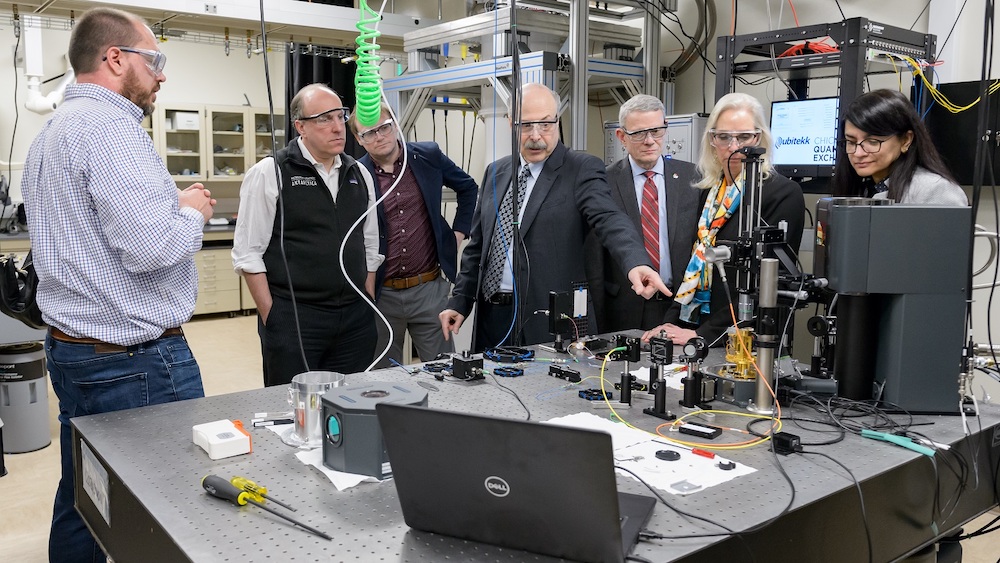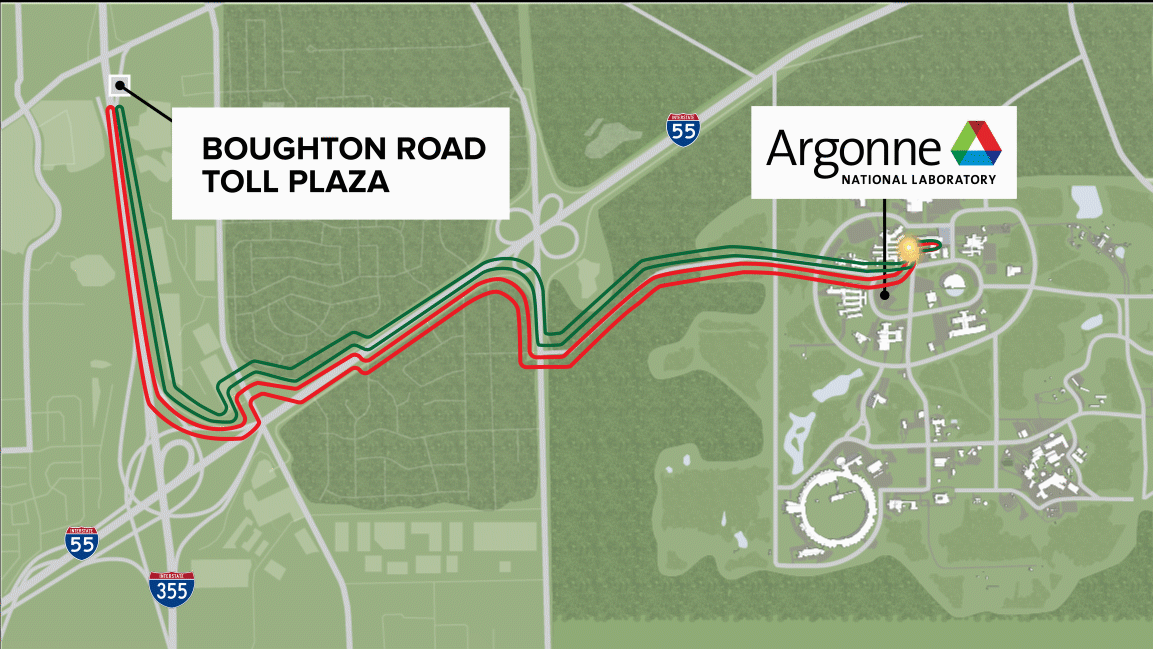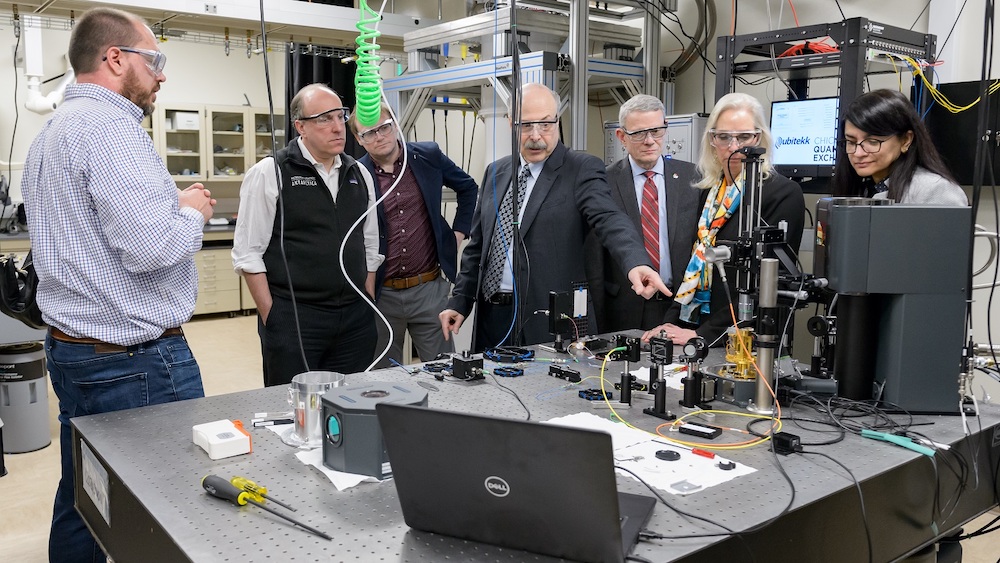
Department of Energy Under Secretary for Science Paul Dabbar and Argonne and UChicago scientists and leaders discuss quantum entanglement along Argonne’s quantum loop, a 52-mile fiber optic testbed for quantum communication in the Chicago suburbs. (Image by Argonne National Laboratory.)
Scientists from the U.S. Department of Energy’s (DOE) Argonne National Laboratory and the University of Chicago entangled photons across a 52-mile network in the Chicago suburbs, an important step in developing a national quantum internet.
The quantum loop, spearheaded by Argonne senior scientist and UChicago professor David Awschalom, ran its first successful entanglement experiments on February 11. Headquartered at Argonne, the loop is amongst the longest land-based quantum networks in the nation.
“By integrating communities with our national lab system, we can look forward to a future filled with innovation and collaboration.” — Under Secretary for Science Paul Dabbar
The experiment, funded by DOE’s Office of Science Basic Energy Sciences, is seen as a foundational building block in the development of a quantum internet — potentially a highly secure and far-reaching network of quantum computers and other quantum devices. A quantum internet could catalyze technologies that greatly accelerate today’s internet, significantly improve the security of communications and support dramatic advances in computing and sensing. Scientists say quantum technology could revolutionize national and financial security, patient privacy, drug discovery and the design and manufacturing of new materials, while increasing our scientific understanding of the universe.
The quantum loop, spearheaded by Argonne senior scientist and UChicago professor David Awschalom, ran its first successful entanglement experiments on February 11. Headquartered at Argonne, the loop is amongst the longest land-based quantum networks in the nation.
“By integrating communities with our national lab system, we can look forward to a future filled with innovation and collaboration.” — Under Secretary for Science Paul Dabbar
The experiment, funded by DOE’s Office of Science Basic Energy Sciences, is seen as a foundational building block in the development of a quantum internet — potentially a highly secure and far-reaching network of quantum computers and other quantum devices. A quantum internet could catalyze technologies that greatly accelerate today’s internet, significantly improve the security of communications and support dramatic advances in computing and sensing. Scientists say quantum technology could revolutionize national and financial security, patient privacy, drug discovery and the design and manufacturing of new materials, while increasing our scientific understanding of the universe.
Quantum Loop Map

Scientists entangle light particles across the quantum loop in the Chicago suburbs. Animation shows the general path, which winds circuitously across a pair of 26-mile loops from Argonne National Laboratory to the I-355 Boughton Rd. Toll Plaza in Bolingbrook, IL. (Image by Argonne National Laboratory.)
“This is an important step forward in harnessing entanglement and building a network to help form the basis of future quantum communication systems,” said Awschalom, the Liew Family Professor in the Pritzker School of Molecular Engineering at UChicago, senior scientist in the Materials Science Division at Argonne and director of the Chicago Quantum Exchange. “We are excited by these initial demonstrations of distributing entanglement outside of a laboratory, as well as having a flexible communications platform that allows us to identify the challenges of translating quantum phenomena to the real world.”
In the subatomic quantum world, particles can become entangled, sharing their states even though they’re in different locations — a phenomenon which could be used to transfer information. The network, which originates at Argonne in Lemont, Illinois, and winds circuitously in a pair of 26-mile loops through several of Chicago’s western suburbs, taps the unique properties of quantum mechanics to eventually “teleport” information virtually instantaneously across a distance. As a bonus, scientists believe the information would be extremely difficult to hack — quantum states change when observed, so the presence of an outside listener would actually change the signal itself.
“By integrating communities with our national lab system, we can look forward to a future filled with innovation and collaboration,” said Under Secretary for Science Paul Dabbar. “The Department of Energy is proud to bring businesses closer to the technology built at Argonne. By developing the quantum loop, we will remain globally competitive around the world.”
The White House on Feb. 11 announced funding and a strategic vision for quantum networks in the United States. The plan envisions companies and national laboratories over the next five years working together to demonstrate the foundational science and key technologies to enable quantum networks, and over the next 20 years, quantum internet links that enable new capabilities not possible with classical technology.
Argonne plans to scale this network by developing a two-way quantum link network with Fermi National Accelerator Laboratory. Such a link could help to lay the foundation for a national laboratory-led, cross-country quantum internet.
“Both locally and nationally, Argonne fosters important industry partnerships that accelerate technology innovation and commercialization,” said Argonne Director Paul Kearns. As part of the Chicago Quantum Exchange, we create pioneering collaborations with industry, which is key to maintaining U.S. leadership in this important emerging field.”
Though quantum technology holds a great deal of promise, it’s mostly theoretical right now; quantum systems are extremely sensitive to interference and to date have been mainly tested in clean, controlled lab environments. This experiment instead runs through an existing underground network of optical fiber, built decades ago for conventional telecommunications.
“In the real world, the fiber cables are expanding and contracting as the temperature changes. There is also vibration and noise from the environment such as local traffics,” said Tian Zhong, Argonne scientist in the Nanoscience and Technology division and assistant professor of Molecular Engineering at UChicago . “These are all factors that can affect the quantum signal transmission, and that we can only find out by performing an experiment of this magnitude under real-world operating conditions.”
“Many tests of quantum technologies are confined to a research environment,” said Alan Dibos, Argonne assistant scientist in the Nanoscience and Technology division. “One of the exciting aspects of this project is the expansion of our laboratory into the greater Chicago area.”
In achieving this milestone, Awschalom and team worked closely with companies in the emerging quantum industry. In partnership with Qubitekk, a new company developing quantum technologies, the team created entangled photon pairs and distributed them across two 26-mile fiber loops. The returning photon pairs were detected, and their correlation was verified with a high signal-to-noise ratio.
The result is the latest from members of the Chicago Quantum Exchange, a national leader in quantum information science. The exchange includes more than 130 members from universities and national laboratories, including founding members UChicago, Argonne, Fermilab and the University of Illinois at Urbana-Champaign. The exchange also includes several nonprofit and international partners and seven corporate partners, all of which have expertise in varying areas of quantum information technology.
The quantum loop is supported by DOE’s Office of Science. Additional support for this experiment was provided by the Joint Task Force Initiative, a University of Chicago program dedicated to helping Argonne and Fermilab achieve mission success.
“This is an important step forward in harnessing entanglement and building a network to help form the basis of future quantum communication systems,” said Awschalom, the Liew Family Professor in the Pritzker School of Molecular Engineering at UChicago, senior scientist in the Materials Science Division at Argonne and director of the Chicago Quantum Exchange. “We are excited by these initial demonstrations of distributing entanglement outside of a laboratory, as well as having a flexible communications platform that allows us to identify the challenges of translating quantum phenomena to the real world.”
In the subatomic quantum world, particles can become entangled, sharing their states even though they’re in different locations — a phenomenon which could be used to transfer information. The network, which originates at Argonne in Lemont, Illinois, and winds circuitously in a pair of 26-mile loops through several of Chicago’s western suburbs, taps the unique properties of quantum mechanics to eventually “teleport” information virtually instantaneously across a distance. As a bonus, scientists believe the information would be extremely difficult to hack — quantum states change when observed, so the presence of an outside listener would actually change the signal itself.
“By integrating communities with our national lab system, we can look forward to a future filled with innovation and collaboration,” said Under Secretary for Science Paul Dabbar. “The Department of Energy is proud to bring businesses closer to the technology built at Argonne. By developing the quantum loop, we will remain globally competitive around the world.”
The White House on Feb. 11 announced funding and a strategic vision for quantum networks in the United States. The plan envisions companies and national laboratories over the next five years working together to demonstrate the foundational science and key technologies to enable quantum networks, and over the next 20 years, quantum internet links that enable new capabilities not possible with classical technology.
Argonne plans to scale this network by developing a two-way quantum link network with Fermi National Accelerator Laboratory. Such a link could help to lay the foundation for a national laboratory-led, cross-country quantum internet.
“Both locally and nationally, Argonne fosters important industry partnerships that accelerate technology innovation and commercialization,” said Argonne Director Paul Kearns. As part of the Chicago Quantum Exchange, we create pioneering collaborations with industry, which is key to maintaining U.S. leadership in this important emerging field.”
Though quantum technology holds a great deal of promise, it’s mostly theoretical right now; quantum systems are extremely sensitive to interference and to date have been mainly tested in clean, controlled lab environments. This experiment instead runs through an existing underground network of optical fiber, built decades ago for conventional telecommunications.
“In the real world, the fiber cables are expanding and contracting as the temperature changes. There is also vibration and noise from the environment such as local traffics,” said Tian Zhong, Argonne scientist in the Nanoscience and Technology division and assistant professor of Molecular Engineering at UChicago . “These are all factors that can affect the quantum signal transmission, and that we can only find out by performing an experiment of this magnitude under real-world operating conditions.”
“Many tests of quantum technologies are confined to a research environment,” said Alan Dibos, Argonne assistant scientist in the Nanoscience and Technology division. “One of the exciting aspects of this project is the expansion of our laboratory into the greater Chicago area.”
In achieving this milestone, Awschalom and team worked closely with companies in the emerging quantum industry. In partnership with Qubitekk, a new company developing quantum technologies, the team created entangled photon pairs and distributed them across two 26-mile fiber loops. The returning photon pairs were detected, and their correlation was verified with a high signal-to-noise ratio.
The result is the latest from members of the Chicago Quantum Exchange, a national leader in quantum information science. The exchange includes more than 130 members from universities and national laboratories, including founding members UChicago, Argonne, Fermilab and the University of Illinois at Urbana-Champaign. The exchange also includes several nonprofit and international partners and seven corporate partners, all of which have expertise in varying areas of quantum information technology.
The quantum loop is supported by DOE’s Office of Science. Additional support for this experiment was provided by the Joint Task Force Initiative, a University of Chicago program dedicated to helping Argonne and Fermilab achieve mission success.




 IonQ Achieves Industry Leading Performance on Next Generation Barium Qubits
IonQ Achieves Industry Leading Performance on Next Generation Barium Qubits